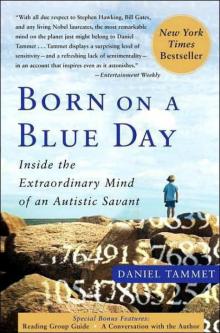Born on a Blue Day: Inside the Extraordinary Mind of an Autistic Savant


Author: Daniel Tammet
Category: Nonfiction
Published: 2007
Series:
View: 408
Read OnlineBorn on a Blue Day is a journey into one of the most fascinating minds alive today—guided by the owner himself. Daniel Tammet is virtually unique among people who have severe autistic disorders in that he is capable of living a fully independent life and able to explain what is happening inside his head. He sees numbers as shapes, colors, and textures, and he can perform extraordinary calculations in his head. He can learn to speak new languages fluently, from scratch, in a week. In 2004, he memorized and recited more than 22,000 digits of pi, setting a record. He has savant syndrome, an extremely rare condition that gives him the most unimaginable mental powers, much like those portrayed by Dustin Hoffman in the film Rain Man. Fascinating and inspiring, Born on a Blue Day explores what it’s like to be special and gives us an insight into what makes us all human—our minds.From Publishers WeeklyThis unique first-person account offers a window into the mind of a high-functioning, 27-year-old British autistic savant with Asperger's syndrome. Tammet's ability to think abstractly, deviate from routine, and empathize, interact and communicate with others is impaired, yet he's capable of incredible feats of memorization and mental calculation. Besides being able to effortlessly multiply and divide huge sums in his head with the speed and accuracy of a computer, Tammet, the subject of the 2005 documentary Brainman, learned Icelandic in a single week and recited the number pi up to the 22,514th digit, breaking the European record. He also experiences synesthesia, an unusual neurological syndrome that enables him to experience numbers and words as "shapes, colors, textures and motions." Tammet traces his life from a frustrating, withdrawn childhood and adolescence to his adult achievements, which include teaching in Lithuania, achieving financial independence with an educational Web site and sustaining a long-term romantic relationship. As one of only about 50 people living today with synesthesia and autism, Tammet's condition is intriguing to researchers; his ability to express himself clearly and with a surprisingly engaging tone (given his symptoms) makes for an account that will intrigue others as well. (Jan.) Copyright © Reed Business Information, a division of Reed Elsevier Inc. All rights reserved. From BooklistStarred Review Although Tammet is only 27, his autobiography is as fascinating as Benjamin Franklin's and John Stuart Mill's, both of which are, like his, about the growth of a mind. Not that Tammet is a scientist-statesman or philosopher. He is an autistic savant who can perform hefty arithmetical calculations at lightning speed and acquire speaking competency in a previously unknown language in mere days (the latter capability he used to create the Web-based language-learning systems with which he supports himself). More socially competent and independent than the autistic savant famously played by Dustin Hoffman in Rain Man, Tammet shares his peers' strong preferences for routine, peace and quiet, private space, and literalness, as well as aversion to chance occurrences, aural and informational noise, and figurative language (despite his arithmetical gift, he can't do algebra; he reads a lot but never fiction). He learned fellowship very gradually and says he couldn't really acknowledge his eight siblings until he grew up. He also writes some of the clearest prose this side of Hemingway; he tells his story with such concentration, precision, and simplicity that his familial poverty, schooling as a "mainstreamed" student, self-realization as gay, and embracing of Christianity prove as enthralling as they are, ultimately, normal. Ray OlsonCopyright © American Library Association. All rights reserved
 The Burning of Moscow
The Burning of Moscow Shadow of Doubt
Shadow of Doubt Royal Charles: Charles II and the Restoration
Royal Charles: Charles II and the Restoration The Incest Diary
The Incest Diary A Dead Man in Deptford
A Dead Man in Deptford_preview.jpg) The Demon Train (Book #1 in the Rachel Payne Horror Series)
The Demon Train (Book #1 in the Rachel Payne Horror Series) The Popular Story of Blue Beard
The Popular Story of Blue Beard Dancing In a Jar
Dancing In a Jar